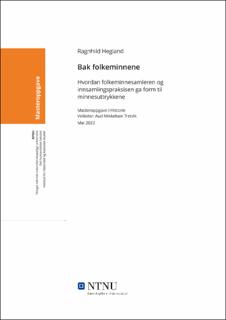| dc.contributor.advisor | Tretvik, Aud Mikkelsen | |
| dc.contributor.author | Hegland, Ragnhild | |
| dc.date.accessioned | 2022-07-13T17:22:09Z | |
| dc.date.available | 2022-07-13T17:22:09Z | |
| dc.date.issued | 2022 | |
| dc.identifier | no.ntnu:inspera:111531354:72652265 | |
| dc.identifier.uri | https://hdl.handle.net/11250/3005291 | |
| dc.description.abstract | I denne oppgaven undersøker jeg folkeminnesamlingens praksis. Jeg belyser hvordan folkeminnesamlingene oppsto, fra innsamlingen av enkeltfortellinger i bygdesamfunn, til ferdige samlinger. I oppgavens problemstilling stiller jeg spørsmål ved hvordan samleres innsamling av folkeminnene, så vel som utgivelsesprosessen, påvirket folkeminnenes form og innhold. Oppgaven undersøker også aktørene involvert, både innsamlerne og deres bakgrunn og holdninger, og de mer usynlige informantene, og hvordan de kommer til syne i prosessen.
I tillegg tar undersøkelsen for seg hvordan folkeminnesamlingene fungerer som minnesteder, og analyserer samlingene i hvordan de fikk sin betydning, i tillegg til hvordan de fikk sin form. Oppgaven vil også drøfte krysningspunktet mellom folkeminner, lokalhistorie, regional og nasjonal historie, og hvordan de har skapt dagens kulturarv.
Oppgaven er avgrenset til Voss og Vossestrand, og tar utgangspunkt i to samlere, Thrond Sjurson Haukenæs, som var aktiv mellom 1883-1914, og Knut Bjørgaas, aktiv mellom 1917-1945. Jeg sammenligner disse to aktørene i lys av deres roller i lokalsamfunnet og deres sosiale og faglige miljøer. Deretter sammenligner jeg deres innsamlingspraksis og utgivelsespraksis. Slik belyser jeg hvordan folkeminnesamlinger kan være påvirket av maktstrukturer, agendaer og trender i ulike tidrom, og av aktørene involvert. | |
| dc.description.abstract | In this masters thesis, I explore the practice of collecting folk tales, and the construction of the Norwegian cultural heritage. The thesis addresses how the collection practice, the editing of the individual tales into a collection, as well as the process of publishing them, influenced both the form and content of the folk tales. I will also address how the people involved influenced the final results of the folk tale collections. This includes both the folk tale collectors, with their individual backgrounds, ideologies, and social- and professional milieus, as well as the often-invisible informants. I want to illuminate the dialogical aspect of the process.
In addition, I want to analyze the folk tale collections as memory sites, and explore how they became imbued with meaning, as well as how they achieved their form. This thesis discusses the intersection between folk tales, local history, regional and national history, and how cultural heritage is produced in this intersection.
I have limited my analysis to the geographical area of Voss and Vossestrand, to highlight local factors as well as national and regional ones. I have focused on two collectors: Thrond Sjurson Haukenæs, who was active between 1883-1914, and Knut Bjørgaas, who was active between 1917-1945. I compare these two collectors in light of their roles in the local community, and their social and professional environments. Following that, I compare the practice of their collection and their publication practices. Thus I highlight how folk tale collections are the results of various power structures, agendas and tendencies in different generations. | |
| dc.language | nob | |
| dc.publisher | NTNU | |
| dc.title | Bak folkeminnene: Hvordan folkeminnesamleren og innsamlingspraksisen ga form til minnesuttrykkene | |
| dc.type | Master thesis | |
